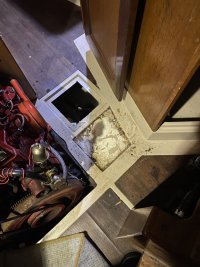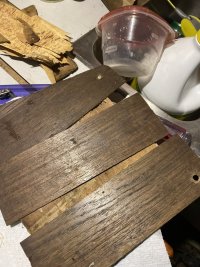Hey Bob,
While you're at that stage, can you please work out what paths can bring water to the bilge where the forwardmost keel bolt is? After leaving the boat for a while, I can suck a good bit of water out through the weep hole at the forward end of the keel step that leads to the bilge area. The bilge just aft of the mast is where my down-the-mast water collects. I can't work out how water gets into the bilge forward of the mast.
If I ever replace my cabin sole, I'll make an access panel in the sole above that area to give access to that keel bolt.
The labyrinth called the TAFG on our E32-3s have always been sort of a mystery and written about many times on this site. Water seems to appear and disappear before and after a sail. I have a leak, someplace aft...I think, that delivers water to the main bilge but only sometimes. It can rain like the devil and the bilge will remain bone dry, or a light rain can leave a half inch of water but I suspect that it maybe water from another part of the hull that gets into where I can see it in the main bilge after a spirited sail.
The area you're questioning is one of those mysterious places in the TAFG where reaching the forward keel bolt is a bit problematic. While on the hard this winter I had a small "smiling" crack in forward part of the keel where it meets the hull. After some examination by me and the yard we determine that it wasn't anything that needed nothing more the some patching but as part of the process the yard suggested that I have the keel bolts tightened to specs. I'd do this sort of thing myself but I live two hours from the boat and its much easier for the yard to do the job.
I warned them about the hidden forward keel bolt which they accessed by way of a small removable panel in the port settee next to the mast. Unfortunately I have no photos of that area. All bolts were tightened and no problems were found and there was no report of water in that forward area of the TAFG. I can't speak as to how water is gaining access to this part of your boat aside from suggesting that maybe that forward keel bolt needs tightening and keel connection needs to be examined. However, it could be just water sloshing around the TAFG and ending up far from a place where it entered the boat.
I've attached a photo of the areas where I pulled the old T&H up and as you can see there is a "pan" in the TAFG adjacent to the area where the forward keel bolt is located covered by a wooden panel. After examining the wooden covers over these areas I determined that they were solid and showed no signs of delimitation or rot so I'm gonna let them be. Like my dad use to say, "If it ain't broke don't fix it." But with my plans of screwing the new T&H sole pieces down, if there is ever a problem it'll be much easier to access them.
The other photo I've attached is the TAFG more exposed (and the mast removed) with the wood "pan" covers off and this BTW is NOT my boat but that of Geoff Johnson, another E32-3 owner who I hope forgives me for pirating his image. As you can see the pan area next to the forward keel bolt is sealed but I suppose that you could make an access hole there (maybe) which maybe closer to the keel bolt and allow you to see this area better?














